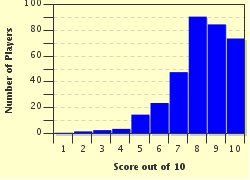Quiz Answer Key and Fun Facts
1. Although Serbs have lived in the area for thousands of years, the Republic of Serbia has only existed since 2006, following the dissolution of Serbia and Montenegro, a state which formed in 1992 as part of the disintegration of Yugoslavia. In 2008, one of its southern provinces declared themselves to be an independent nation, which has been recognised by a number of other countries, but not by Serbia. Which of these is being described?
2. As part of your holiday in Serbia, you might consider taking a river cruise along one of Europe's major rivers, shown here in flood during 2006. Which of these rivers flows through northern Serbia on its route from the Black Forest to the Black Sea?
3. Another popular tourist activity in Serbia is visiting one of its numerous Orthodox monasteries. Visitors to the Mileseva monastery near Prijepolje admire this piece of medieval artwork on the building's walls. What style of art is this?
4. One of Serbia's major music festivals takes place in Guča, a town of about 2,000 people located three hours away from Belgrade. What brass instrument is featured in performances at the Dragačevo Assembly?
5. This picture shows two pages of a book known as Miroslav's Gospel because it was created at the request of Miroslav of Hum in the late 12th century. Of what kind of manuscript is it an example?
6. This 1919 painting by Uros Predić illustrates a famed Serbian epic poem, whose title is the same as that of the painting. Which of these is it?
7. These people are performing a traditional folk dance which has many variants throughout the Balkans. Which of these is it?
8. This photo shows a poster for the first movie made and released anywhere in the Balkans, titled 'The Life and Deeds of the Immortal Vozd Karađorđe'. How would one describe the subject of this 1911 silent biographical film?
9. Serbia has had a number of internationally successful athletes during the 20th and 21st centuries. Which of these would NOT have used the equipment in the photo in their chosen sport?
10. Serbia claims to be the home of Slivovitz, which is considered its national drink. What fruit is used as the base for this strong distilled drink?
Source: Author
looney_tunes
This quiz was reviewed by FunTrivia editor
trident before going online.
Any errors found in FunTrivia content are routinely corrected through our feedback system.

